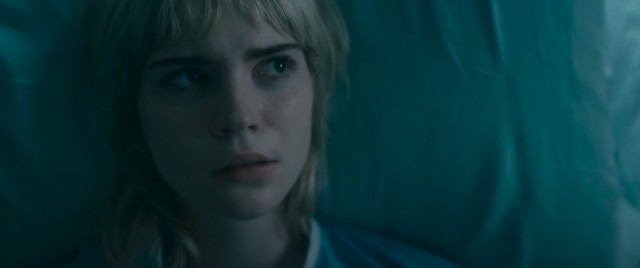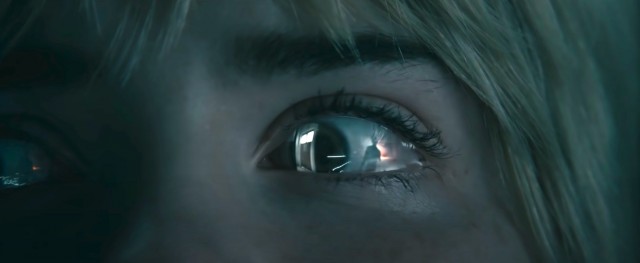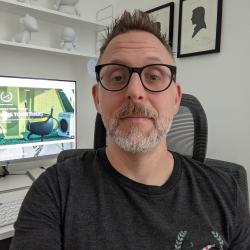We’ve seen the horrific monsters of horror films attack their victims in a number of ingenious ways, leaving audiences haunted by their actions long after the credits roll. Whether you were afraid to sleep after watching Freddy Krueger do his thing, terrified of clowns after being introduced to Pennywise or even fearful of the TV after seeing Sadako Yamamura climb out of it, we all have that one lingering fear that continues to spook us, even as adults. In Spenser Cohen’s 10-minute horror short Blink, it’s not so much the creature in the film that will give you nightmares, but the situation its protagonist Mary finds herself in – paralysed and with no way of stopping her own personal demon reek its havoc.
With the first minute of the film told from Mary’s perspective, we experience her slip in and out consciousness, catching clips of muffled conversations as she battles to escape the haze of the coma she’s been in. Upon waking, the film transitions from this first-person viewpoint and a friendly nurse fills our protagonist (and the audience) in on the events leading to her immediate situation. A couple of tests later its confirmed, for everyone, that’s she’s currently paralysed. If things weren’t bad enough for Mary, after the nurse asks her a serious of questions – which she replies to through a simple one blink for no, two blinks for yes, system – we soon learn she was push out of window, but her attacker was neither man nor woman.

Sophie Thatcher (Yellowjackets, The Book of Boba) stars as Mary, a young woman left paralysed after an encounter with a murderous being
From here intrigue is raised and we start to get an inclination of the true horror of the situation which Mary finds herself and we only have wait about 40-seconds after the conversation to find the source of our victim’s terror. As the nurse leaves, strange “clicking” noises begin to emanate from within the room and as we hear the door creak to a close, we’re introduced to Blink’s monster. The creature reveal isn’t the sudden jump (a now predictable staple of horror shorts) you might have been expecting though, the close of the door reducing light levels in the room and unveiling the monster behind. Drenched in shadow, we can only just make out its long limbs and insect-like eyes and we only get to view it briefly, the edit cutting between the being and Mary, before the nurse reenters and it’s gone. For now.
It’s not long until its back though and this time we don’t even need to see it to understand the treat it poses. Now undetectable, it attempts to finish what it started, opening the room’s window, rolling Mary’s bed over to it and raising her bed until she begins to slip out. Once again the friendly nurse comes to the rescue, but now the monster’s had enough and no longer cares about hiding from her. The film culminates with a slow zoom into Mary’s left-eye, an excellent and really effective sequence where we witness, in the eye’s reflection, the hospital worker dragged to the ceiling by her hair and thrown about like a rag doll. The door to the room once again closes and we’re engulfed in darkness, it would have been an almost perfect ending, if it wasn’t for the Cohen and his team decided we needing one last, unnecessary look at their demon with…you guessed it…a final jump scare.

The final scene of Blink is shot entirely in the reflection of Mary’s eye
It’s somewhat frustrating the short climaxes in such a predictable way, for me it would be much more unsettling if we were just left alone in the gloom, alongside Mary and some creepy sound design. It’s not even like the creature design is particularly novel, coming across as part alien from M. Night Shyamalan’s Signs and part generic demon template. Putting this minor complaint to one side however, Blink is undeniably effective and for the majority of its seven-minute runtime (ok one more complaint – it has almost three-minute of credits!) it feels like old school horror, the kind that wants to do more than just make you jump and instead opts for slowly-building tension and unshakable terror.
Basing the concept around the “fear that we all have when we wake up at three in the morning in our bed, and we think we’ve heard a noise, or we see something in the darkness”, Cohen co-wrote the film with Anna Halberg – who also produces alongside Scott Glassgold. Needing a performer who could help propel the film with some excellent eye-acting (Mary doesn’t do anything but communicate with her eyes throughout the film), they cast relative unknown Sophie Thatcher, who Glassgold must have known from creating the Prospect feature with. Thatcher is an inspired choice, and not only because she’s become a recognisable face after starring in Yellowjackets and The Book of Boba Fett, but she manages to portray all the necessary fear and desperation without ever uttering a word.
The first short created as part of the Scream Gems horror lab, a collaboration between Screen Gems and Glassgold’s Ground Control looking to focus on creating genre proof-of-concept shorts, Blink screened at SXSW ’22 before launching on the Sony Pictures YouTube channel almost immediately afterwards. With Scream Gems openly looking to create films/concepts that can be expanded further and with Cohen and Halberg originally coming-up with the Blink premise with a feature in mind, we wouldn’t be surprised if we saw more from the universe in the future. For now though, Cohen and Halberg are continuing to work with Screen Gems, scripting an adaption of Nicholas Adams’ novel Horrorscope.

 Rob Munday
Rob Munday